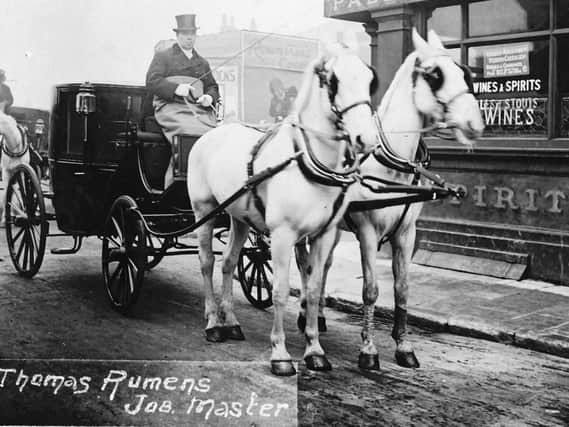Horse-drawn cabs were the original Uber


There was only one person to ask about the carriage, and that was Brian Clifford.
Here he tells draws on his wealth of knowledge on the subject.Â
Advertisement
Hide AdAdvertisement
Hide Ad'The foremost coach is a Landau '“ not to be confused with the more elegant  canoe' Landau.
'˜It was a four-wheeled carriage which could be drawn by one, two or three horses (or mules). I suspect the rear vehicle is of a similar class.
'˜The Landau was very popular with hackney proprietors. The term '˜hackney carriage' referred specifically to vehicles licensed to ply for hire '“ which meant they could be hired off a cab-stand or hailed when moving.
'˜However, the driver could not loiter in the hope of being hailed and could not refuse a legitimate fare.'
Advertisement
Hide AdAdvertisement
Hide AdBrian said researching Portsmouth horse cabs was a struggle.
'˜So many newspaper reports use the term '˜hansom cab' but I feel this may be a little misleading.
'˜The hansom cabriolet was a very specific speedy two-wheeled vehicle popular in London, Paris, Dublin and other major cities.
'˜The driver controlled the horse and the revenue from the rear of the carriage.
Advertisement
Hide AdAdvertisement
Hide Ad'˜It may have been found in Portsmouth, but I suspect the Landau, canoe Landau, Victoria and Brougham would have been the local smaller carriages of choice, with the brake, waggonette and omnibus serving larger parties.
'˜Thomas Rumens was a horse-cab proprietor operating at least from 1908 until 1909 from 59, Station Street, Landport.
'˜In June 1908 one of his employees, a driver named Richard Briant was driving a single-gorse Landau fromBishop Street into railway View and back to the stables.
'˜A lady who was somewhat deaf crossed in front of Briant, was struck by a wheel of the cab and subsequent to having a leg amputated at Portsmouth Royal Hospital, died.
Advertisement
Hide AdAdvertisement
Hide Ad'˜The horse panicked and ran away but was halted by Rumens.
'˜At the inquest which followed, Briant was exonerated of all blame.
'It seems likely that the arrival of the motor taxi-cab in Portsmouth may have influenced Rumens' thinking.
'˜He was obviously downsizing in October 1909 when he advertised for sale 'two horses, Landaus, Governess cars, gig, saddles and bridles; cheap to clear'.
Advertisement
Hide AdAdvertisement
Hide Ad'˜This gives a clue to the title in the picture, 'Job master' which is more usually expressed as one word.Â
'˜A jobmaster was a very necessary tradesman in the 19th century.
'˜A little like the self-hire car companies of today, he hired out horses, gigs, flys, and traps to those who wished to travel but did not have their own conveyances.
'˜He also provided livery, and was often an inn keeper.
'As to the first taxi in Portsmouth, horse drawn hackney carriages were always referred to as 'cabs'Â and they considerably pre-date the first report of Rumens, although we do not know the exact date he commenced business.
Advertisement
Hide AdAdvertisement
Hide Ad'˜We do know, however, that the cab trade was well established  by 1878.
'˜The title 'taxi cab'Â came into use with the motor hackney carriage.
'˜The first licenses were obtained by the Southsea Automobile Company Limited of which a Mr Gettingby was manager in April 1908. Four Argyll Hampshire Laundette cars  with taximeters and striped in yellow were launched and thus, the death knell of the horse cab was sounded.'
Although there is no proof, Brian thinks this is a posed photograph. The driver is most certainly Thomas Rumens.
Advertisement
Hide AdAdvertisement
Hide AdHe is extremely well dressed for a cabby. The two ponies appear in good condition for cab horses.
As far as can be seen, the driver of the second carriage is smart and he has control of what appears to be a handsome white horse.
If anyone recognises the pub, with an advert for the Colosseum, please let me know.
On September 4, I published a photo of the LDB on the corner of Commercial Road and Arundel Street.
Above the corner window was the name J. Parkhouse.
Advertisement
Hide AdAdvertisement
Hide AdI asked if anyone knew who this person was and Frank Jarvis tells me: '˜J. Parkhouse (John, I think) was part (head?) of the family who owned LDB.
'˜I cannot remember all the details from my banking days but I think there were brothers and sons involved as directors. This was in the 1960s.'Â
Thank you, Frank. Â